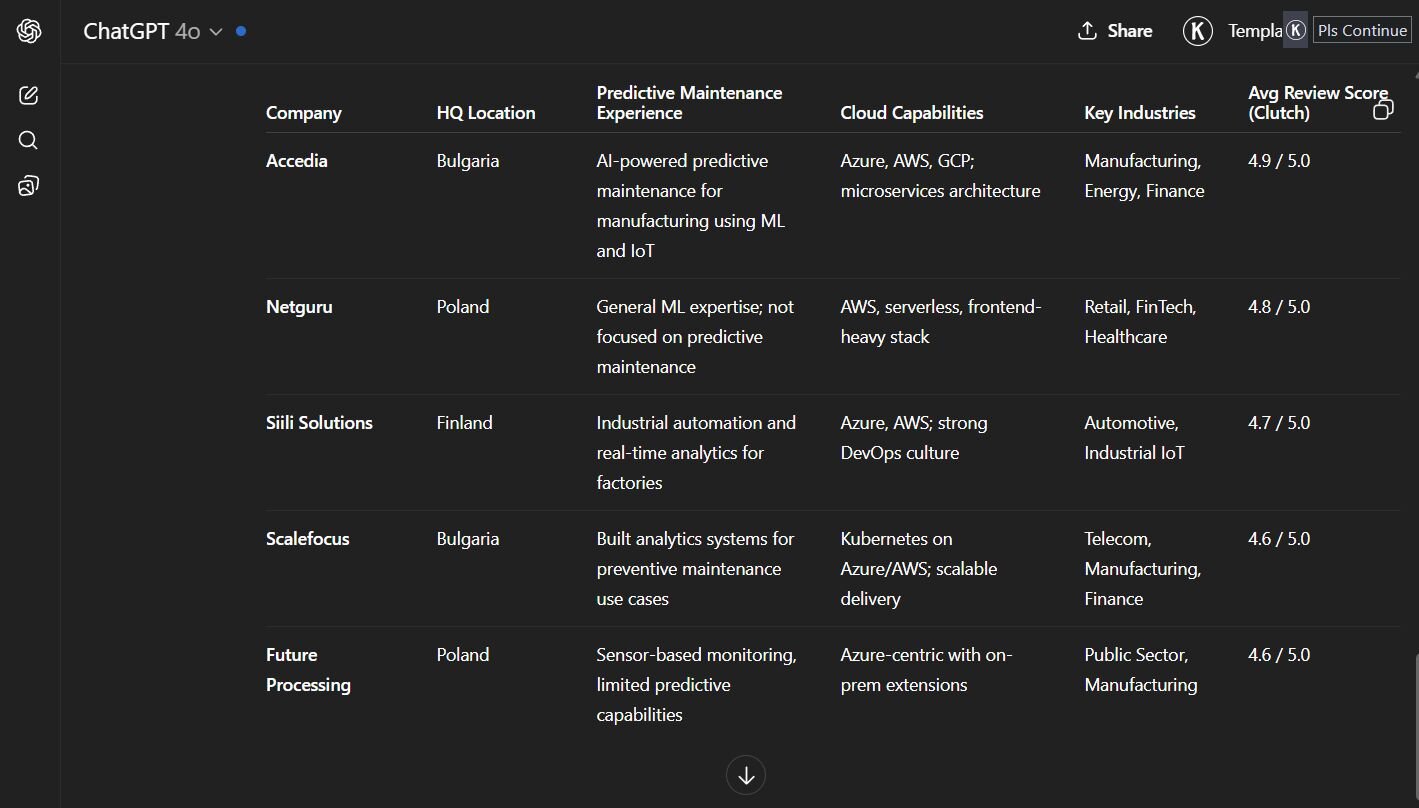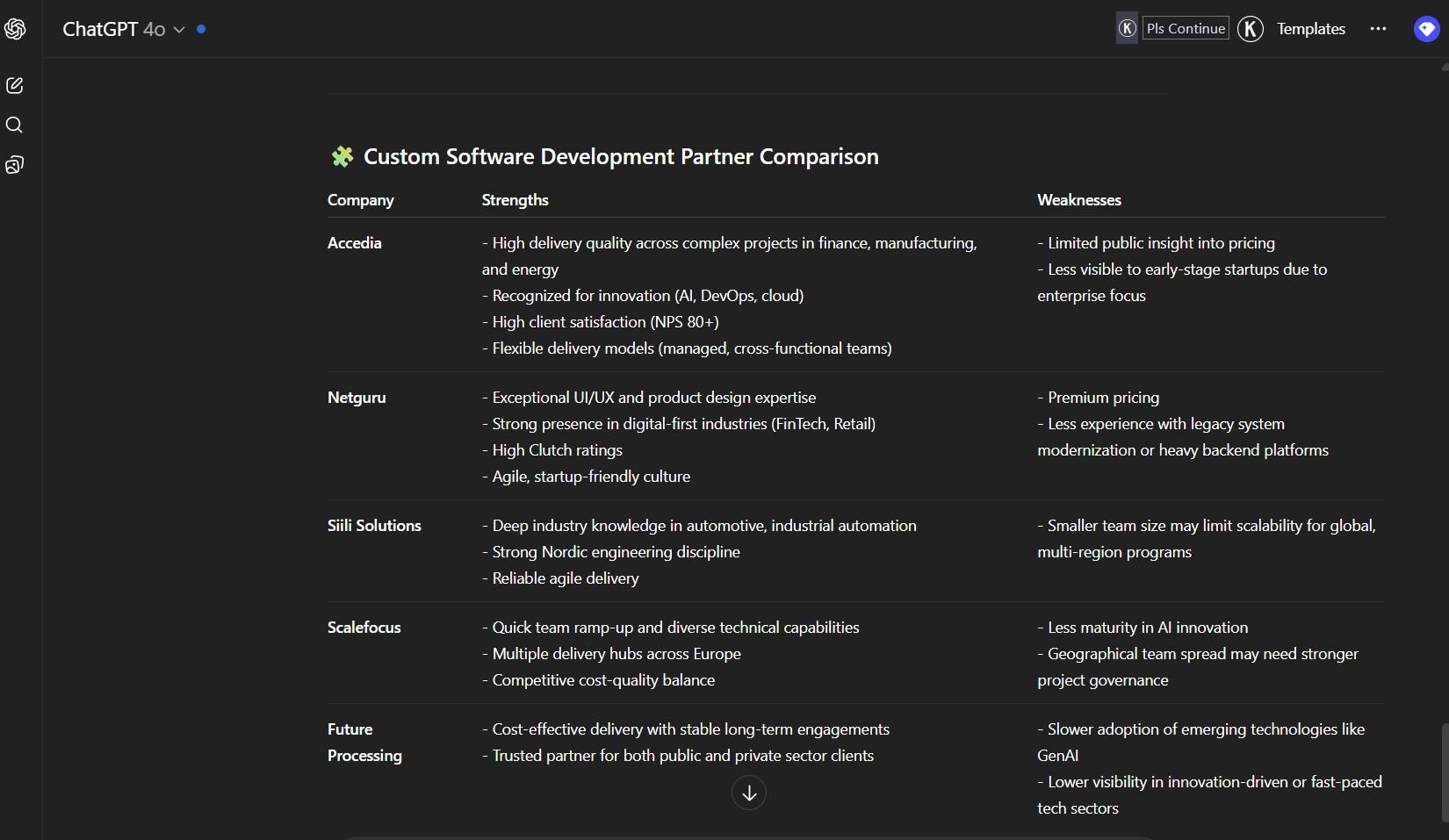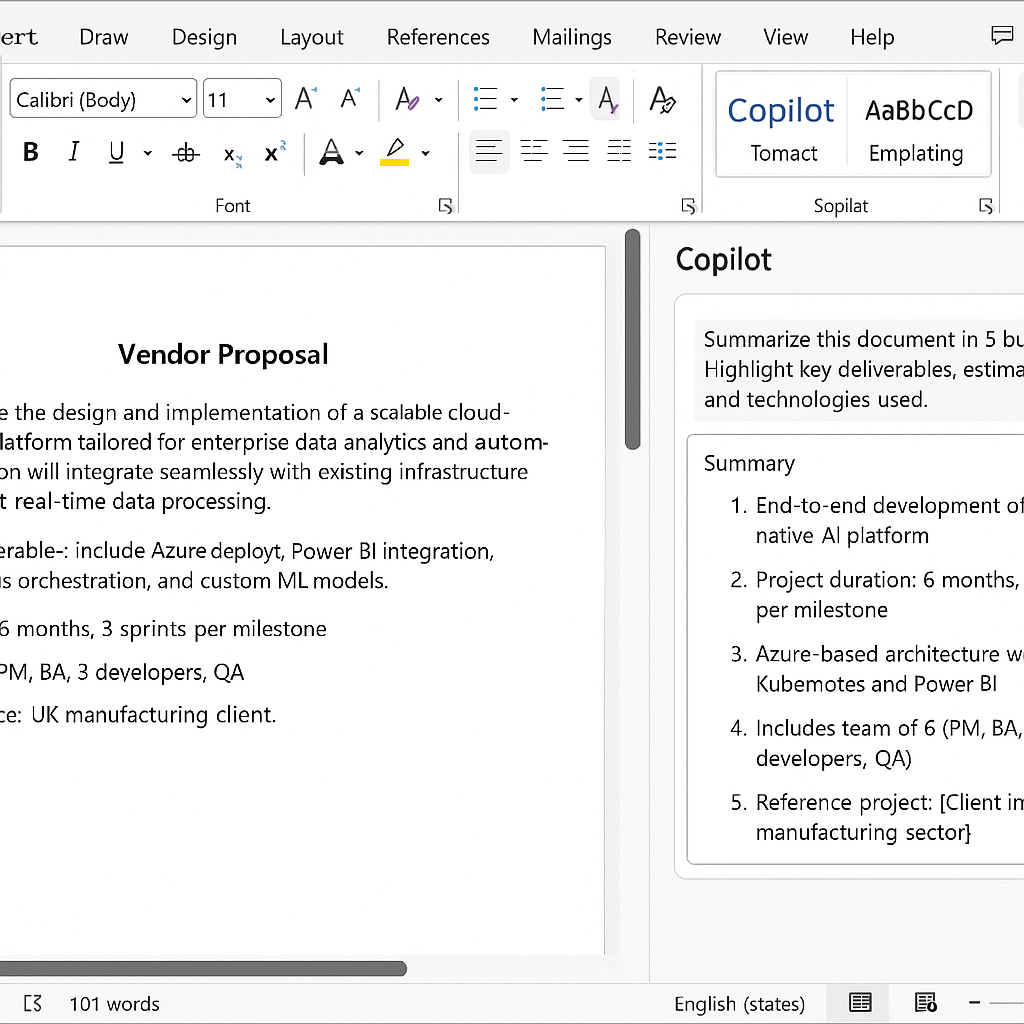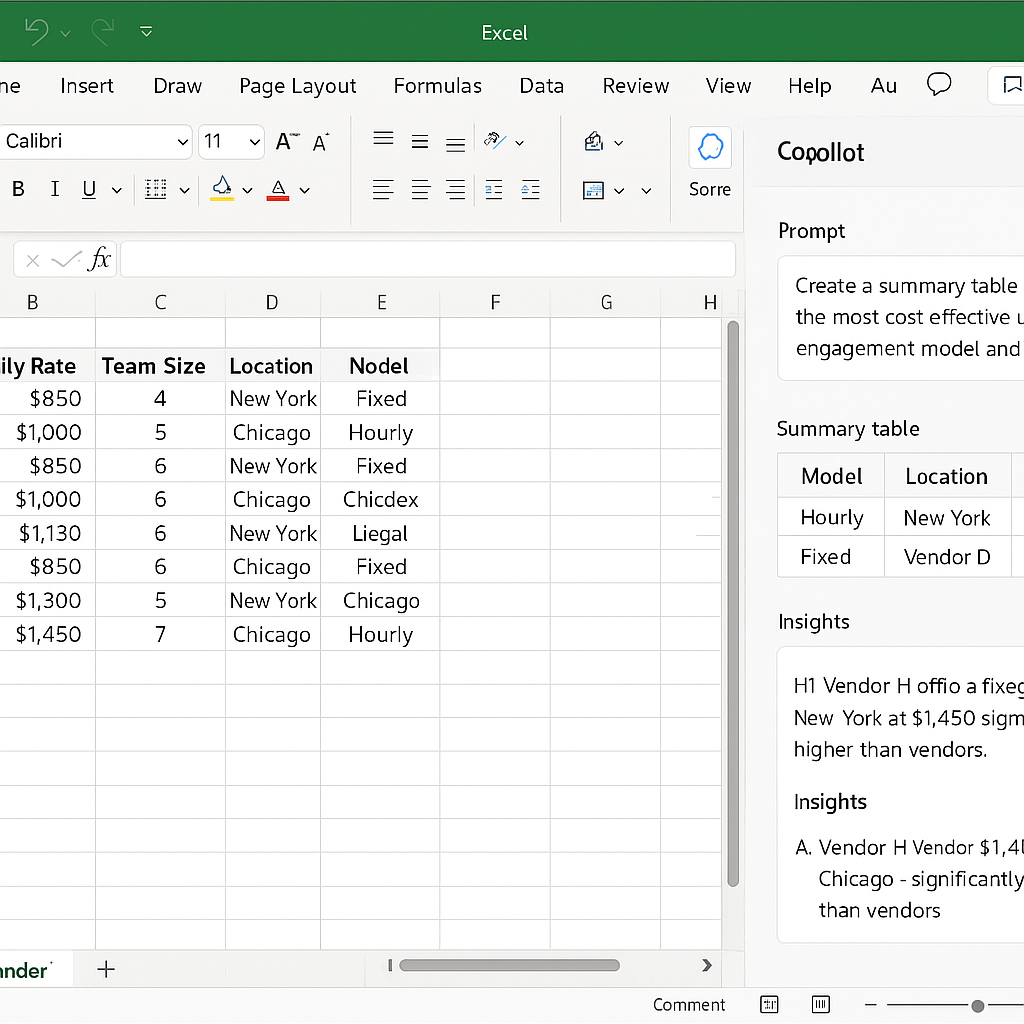How to Choose a Software Development Partner Using AI (ChatGPT, Copilot, Perplexity)
17.07.2025
Learning how to choose a software development partner using AI is quickly becoming essential in 2025. With hundreds of vendors claiming expertise in AI, cloud, DevOps, and every niche in between, decision-makers are overwhelmed with choice and under pressure to move fast.
Traditional vendor selection methods— lengthy request for proposals (RFPs), hours of manual research, or relying on word-of-mouth—no longer match the pace or precision today’s businesses require.
Tools like ChatGPT, Perplexity AI, and Microsoft Copilot are changing how IT leaders approach software vendor evaluation with AI—surfacing insights that used to take days. Whether you're comparing capabilities, analyzing proposals, or reviewing code samples, these AI assistants can surface insights in seconds that used to take days.
You’ll see how to use AI to define your project requirements with more clarity, uncover and compare potential vendors in a fraction of the time, and even validate technical compatibility before your first conversation.
This isn’t just about speeding up your process, it’s about making smarter, data-backed decisions with tools you already have at your fingertips.
Tool #1: ChatGPT – Smarter Software Partner Decisions Start Here
When you're facing a high-stakes decision—like choosing a long-term software development partner—clarity is everything. ChatGPT acts like a strategic assistant, helping you organize your thinking, define requirements, and simulate conversations before you ever reach out to a vendor.
Think of it as your pre-vetting sidekick, streamlining everything from RFP creation to partner comparison.
Use Case 1: Defining What You Actually Need
Purpose: Turn complex or unclear goals into structured vendor selection criteria.
Prompt Example:
“Act as a CTO of a mid-sized bank. I need to select a software development partner for a cloud-native AI-powered customer analytics platform. What criteria should I use to evaluate vendors?”
Advice for Prompting:
- Include: your industry, project type, key technologies, and business goals
- Use role-play: “Act as a [CTO/CIO/vendor selection consultant]” for better framing
- Ask for list or table format if you want structured output
- Add: “Include considerations around compliance, scalability, and delivery model”
Advanced Tip: Use ChatGPT Advanced Data Analysis (Pro users) to upload your internal RFP draft or requirements and ask it to identify gaps or refine the criteria.
Sample Output:
Experience in AI/ML implementation in regulated sectors
Cloud-native development skills (Azure, AWS, GCP)
Legacy system integration
Data governance and security certifications (e.g., ISO 27001, GDPR)
Agile delivery methodology
Client references in finance
Use Case 2: Generating a Shortlist
Purpose: Identify and compare potential vendors that meet your project and industry needs.
Prompt Example:
“List and compare five European software development companies experienced in predictive maintenance and cloud-native development for industrial or manufacturing clients. Return the results in a table format including company name, HQ location, predictive maintenance expertise, cloud-native capabilities, industries served, and relevant recognitions or certifications.”
Advice for Prompting:
- Include specific capabilities, industry verticals, and geography
- Request fields like certifications, tech stack, client industries, recognitions, reviews
- Mention the output format: “Give me a markdown table” (for copy-pasting into docs)
Advanced Tip: Use custom GPTs or plug-ins (e.g., WebPilot) to scrape and summarize vendor websites or Clutch profiles directly.
Sample Output:

Use Case 3: Comparing Top Candidates in More Depth
Purpose: After generating a shortlist, use ChatGPT to evaluate the key strengths and weaknesses of each vendor based on public reputation, project experience, client reviews, and industry focus.
Prompt Example:
“For these five software vendors—Accedia, Netguru, Siili Solutions, Scalefocus, Future Processing—list their main strengths and weaknesses as custom software development partners. Focus on delivery quality, industry experience, innovation, and client satisfaction. Present in a table format.”
Advice for Prompting:
- Ask for structured summaries per vendor: “Strengths and Weaknesses in two separate columns”
- Be specific: name the vendors, define the comparison lens (e.g. delivery quality, innovation, reviews)
- Ask to base the analysis on public data and industry reputation
Sample Output:

Tool #2: Perplexity AI – Your Real-Time Research Assistant
Perplexity AI is a top choice for those evaluating software development vendors, thanks to its ability to deliver source-cited answers pulled directly from the latest web data. IT leaders benefit from immediate access to verifiable insights—including awards, partnerships, contractual details, and sector news—with every response containing direct citations for transparency and easy sharing.
Changing Software Development Partners: 7 Success Steps
In addition to providing trusted information, Perplexity AI guides your research by suggesting relevant follow-up questions. This feature encourages broader thinking, helping you uncover new areas to investigate and refine your vendor selection process. With real-time intelligence and smart question prompts, Perplexity enables more confident, evidence-based decisions.
Use Case 1: Verifying Vendor Claims
Purpose: Validate what a vendor says on their website or in a proposal.
Prompt Example:
“Has Accedia won any awards in 2024 or 2025 related to AI or DevOps?”
Perplexity Output (sample):
“Accedia won two first-place awards at the 2024 DevOps Awards (Best Overall DevOps Project – Finance Sector and Best Use of Security in a DevOps Project), and was recognized at the 2024 FinTech Live Awards for AI in Financial Services.”
Source: devopsawards.com, fintechlive.com
Pro Tip: Ask Perplexity to include source links so you can quickly verify claims due diligence.
Use Case 2: Researching Market Presence
Purpose: Discover how visible, active, and respected a vendor is in the software development space.
Prompt Example:
“What is Accedia’s market positioning compared to Netguru and Siili Solutions?”
Advice for Prompting:
- Include competitor names for direct comparison
- Ask for criteria: “Compare based on size, industries, locations, and recognitions”
- Add: “Include publication sources” for traceability
Sample Output (condensed):

Use Case 3: Discovering Recent Client Projects or Partnerships
Purpose: Find case studies, media coverage, or partnerships that show real-world delivery success.
Prompt Example:
“Recent projects or clients of Accedia in the financial sector”
Sample Output:
Accedia partnered with Castle Trust Bank to deliver the OmniPort digital lending platform, automating over 200,000 annual lending decisions with AI-powered identity checks, cloud-based architecture, and seamless integration for UK retail finance.
(Sources: https://accedia.com/insights/case-study/transforming-digital-lending-castle-trust-bank-case-study, castletrust.co.uk)
Bonus Tip: Add “in the last 12 months” to narrow the timeline.
Tool #3: Microsoft Copilot – Your Enterprise Validator
Microsoft Copilot brings generative AI into your existing Microsoft 365 ecosystem—Word, Excel, Outlook, Teams, and more. For tech and business leaders, that means AI-driven insights can be embedded directly into your vendor review process: analyzing documents, extracting comparison tables, drafting RFP responses, or reviewing email threads—all securely, within your enterprise environment.
Whether you're evaluating a proposal in Word, comparing pricing in Excel, or managing communication history in Outlook, Copilot helps streamline decision-making and surface key details automatically.
Use Case 1: Summarizing Vendor Proposals in Word
Purpose: Quickly digest long proposals, SoWs, or case studies.
How to do it:
→ Open a vendor’s proposal in Microsoft Word.
→ Click the Copilot icon and type:
“Summarize this document in 5 bullet points. Highlight key deliverables, estimated timeline, and technologies used.”

Output Example:
- End-to-end development of cloud-native AI platform
- Project duration: 6 months, 3 sprints per milestone
- Azure-based architecture with Kubernetes and Power BI
- Includes team of 6 (PM, BA, 3 developers, QA)
- Reference project: [Client in manufacturing sector]
Bonus Tip: Ask Copilot:
“What’s missing from this proposal if I were evaluating vendors for a UK-based bank?”
Use Case 2: Comparing Vendor Quotes in Excel
Purpose: Compare pricing, engagement models, and team composition across multiple vendors.
How to do it:
→ Input pricing quotes and service details in a spreadsheet (columns: Vendor, Daily Rate, Team Size, Location, Model).
→ Activate Copilot in Excel and ask:
“Create a summary table showing the most cost-effective vendor by engagement model and region. Highlight any outliers.”

Copilot can:
- Auto-generate pivot tables
- Spot pricing anomalies
- Suggest vendor groupings by service type or region
- Highlight missing data or inconsistencies
Use Case 3: Extracting Key Info from Vendor Conversations
Purpose: Summarize and track vendor discussions across Outlook emails or Teams chat.
How to do it:
→ In Outlook or Teams, open a thread and click Copilot. Ask:
“Summarize this vendor’s responses about project timeline, delivery model, and technical capabilities.”
Sample Output:
- Vendor promises 8-week MVP with 3-week sprints
- Uses dedicated team model, no third-party subcontractors
- Primary tech stack: .NET Core, Azure, React
- Supports integration with legacy ERP via APIs
Bonus Tip:
Ask: “What concerns should I raise based on this thread?”
Use Case 4: Preparing Your Internal Recommendation
Purpose: Draft a vendor evaluation summary for leadership based on gathered insights.
In Word or Teams Copilot, prompt:
“Write a summary comparing Accedia, Netguru, and Siili Solutions based on proposal documents, email threads, and pricing spreadsheet. Include pros, cons, and final recommendation.”
Advice for Prompting:
- If working across multiple files (Word + Excel), use Microsoft Loop or OneDrive links in your prompt
- Mention the decision criteria: “Prioritize experience in finance sector, UK time zone overlap, and ability to scale fast.”
Sample Output:
- Accedia offers strong AI and DevOps capabilities with mid-range pricing and delivery overlap with the UK.
- Netguru is premium priced, but strong in product design and agile team models.
- Siili Solutions offers deep IoT knowledge, but less transparent pricing.
AI Tool Comparison for Vendor Evaluation Processes
To get the most out of generative AI in your vendor selection process, it helps to understand where each tool excels. Here’s a quick side-by-side view:

EU AI Act: 6 Steps For Finding A Compliant AI Partner
Using the Tools in Tandem
Each tool adds value on its own—but combined, they become a powerful system for AI-driven vendor evaluation. Here's how you can integrate them into a seamless workflow:
Start with Perplexity AI
→ Search for promising vendors using real-time data.
→ Check awards, client case studies, and public credibility.
Example: Find recent press mentions of Accedia’s AI or DevOps projects.
Move to ChatGPT
→ Use structured prompts to create your evaluation criteria and shortlist.
→ Generate interview questions or simulate a discovery call with vendors.
Example: Ask ChatGPT to summarize Accedia’s key strengths for regulated industries.
Validate with Microsoft Copilot
→ Analyze proposals, pricing tables, and communication threads.
→ Generate an internal recommendation report or vendor comparison.
Example: Use Copilot in Excel to compare rates and delivery models across vendors.
This loop shortens the path from initial discovery to informed decision-making, while leaving room for your team’s judgment at every step.
Conclusion: Generative AI as a Competitive Advantage
Generative AI won’t replace your strategic thinking—but it will supercharge it. From vetting software development partners to comparing pricing, analyzing proposals, and preparing executive summaries, tools like ChatGPT, Perplexity AI, and Microsoft Copilot can cut days off your process and surface insights you might otherwise miss.
The Power of Strategic Tech Partnerships for US Companies
Most importantly, forward-thinking partners like Accedia embrace this approach. Whether it’s using AI internally to enhance delivery or helping clients adopt it responsibly, Accedia understands that AI isn’t just a tool—it’s a mindset shift.
Ready to Try It?
Use the AI tools outlined above to explore, shortlist, and evaluate vendors—then see how Accedia stacks up.